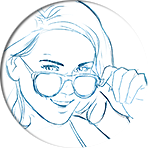This graphic shows a typical timeline of a full service test film production.
Of course, this procedere should be adaptable to the clients individual needs and wishes.
I - THE STORYBOARD AND PROJECT KICKOFF

At the very beginning of the process there is the briefing through the agency. This takes place right after the booking of an illustrator (either one artist or a team of illustrators) - either via an or through various contacts the agency's art buying might have. If possible, the following people should be part of the illustrator briefing: the agency's creative, the producer, (maybe) the account manager, the illustrator and the responsible art director of the commissioned animation production company, who also could be in charge of directing the animatic.
Beside the telephone conference this person can also host a screenshare. On his/her (or the storyboarder´s) screen he/she is able to show scribbled artwork to the other participants of the conference.
Although these live scribbles are done quite quickly and rough, they are extremely helpful to understand the actions and angles that work best to tell the story of the commercial and break it down into shots.
The results should be uploaded onto a project management platform, which gives all parties access to monitor the project process at any given time. By also splitting content into different topics, no file, no feedback or no preview ever gets lost.
This gets all the more important when there are many collaborators working on a project.
II - PENCILS AND ROUGHCUTS
Following the briefing, the illustrator creates the pencils (b/w outlines or preparatory drawings), accompanied by the usual corrections from agency and client. Even this early on in the project, it is advisable to create a so called roughcut. At this stage a layout version of the voice over is sufficient. If desired, music might be added by the , but there´s no animation yet!
With a roughcut you can quickly gain valuable information about what parts of your story may work and what will probably not.
You get answers to questions like "Does the voice over fit the scenes?" Or "Can we stay inside the time limit of the TVC?". If it all works out, the story you are trying to tell can be understood with just artwork and VO, without additional commentary from the copy writer.
III - COLORS AND APPROVAL ARTWORK
After approval of the pencils through the client, the illustrator can go ahead with the colorization of the frames and layers (the basic images of the films and the layers that are needed for animation).
By now, the audio department will have compiled a voice talent casting and might also already have booked slave studios for the recording sessions.
Now that the 4c artwork has been approved, the illustration phase is completed and the team can go ahead with the animation phase.
IV - POSTPRODUCTION - ANIMATION AND AUDIO
Before the operators can start animating, the illustrators´ photoshop-files usually have to be prepared for animation.
This part of the process can be made easier if the illustrator has some experience with animation and knows how certain elements have to be set up.
Based on the roughcut, all the seperate scenes will be animated and, if neccessary, VFX like particles, rain, snow, light or liquids will be added. In case 3D elements are needed, a stringent and seamless compositing is required.
Before the first preview version of the animatic (fully animated and possibly furnished with text supers) can be send to the agency, another decision has to be made: should the voice recording take place before the first preview, so that the voice over takes can be used for this preview? Or is it better to wait until the client has approved the layout VO?
The latter workflow has the benefit of being able to change the text of the VO, if desired. On the other hand, the previews don't sound quite as convincing with only a layout voice over - not as official and sexy as one is accustomed to with professional talents.
As soon as this (mostly philosophical) question is settled, all that's left to do is finetune the image and audio.
This goes on until every last decision maker is satisfied and the final film can be send to market research.





